Notice: Undefined variable: page in /home/vrxdg1855sn3/public_html/wp-content/themes/72tree/content.php on line 15
Notice: Trying to get property 'ID' of non-object in /home/vrxdg1855sn3/public_html/wp-content/themes/72tree/content.php on line 15
3 Flowering Trees for Your Alpharetta and Roswell Yard
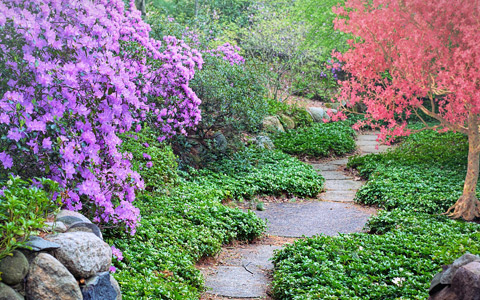
Don’t accept a dull and monochromatic yard. Trees are awakening from their winter slumber and certain species will put on a stunning show of vibrancy and color.
Located in USDA hardiness zone 7b, Alpharetta, Ga is the perfect location for some of the most beautiful flowering trees the South has to offer. If your Alpharetta or Roswell yard doesn’t have one of these trees, you are missing out.
72tree.com gathered care and technical information for flowering dogwood, eastern redbud, and Carolina silverbell blooming tree species perfect for hardiness zone 7b.
Flowering Trees in Alpharetta
The following species are well adapted to the climatic conditions found in Roswell and Alpharetta, Ga. Before choosing a location and breaking ground, read this tree planting guide 72tree.com/tree-planting-guide/
Flowering Dogwood – Cornus Florida is a beautiful tree native to northeastern America, it is hardy in Zones 5 through 9 and flourishes as far west as Texas.
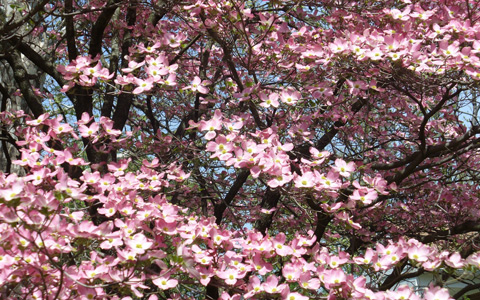
Mature specimens can reach heights of 30 to 35 feet with a crown wider than it is tall. This specimen is considered to be an understory tree with a year-round appeal as it flowers in the spring, maintains attractive foliage throughout summer and fall, and even has an appealing winter appearance.
• Flowering period is April through May with flowers lasting 10 to 15 days.
• Colors include white or pink flowers in spring, bright red fruit in late summer and fall, and light green (spring) dark green (summer) or reddish-purple (fall) foliage.
• Soil should be acidic and well-drained with considerable amounts of organic material.
• Mulch regularly to maintain cool, moist soil.
• Pruning activities should occur either in early or late winter while the tree is in a state of dormancy.
• Susceptible to boring insects, leaf spot, and anthracnose.
When a flowering dogwood must have 25%, or more of its crown pruned to remove an infestation or signs of disease, a certified arborist should be called to evaluate the tree and suggest the best course of action.
Eastern Redbud – Cercis canadensis is noted for being one of the first tree species to flower in the spring. Also native to northeastern America, like the flowering dogwood, it is hardy in Zones 5 through 9 and flourishes as far west as the lower great plains and Texas.
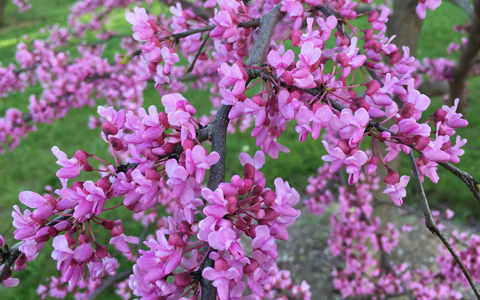
At maturity, the Eastern Redbud reaches heights of 15 to 30 feet with a crown that spreads 25 to 30 feet in diameter. Considered an understory tree, this deciduous specimen provides an incredible show when in bloom.
• Flowering period is March through May before leaf growth. Flowers bloom over the entire crown, creating a “tree of flowers.”
• Colors include pink to reddish-purple flowers, giving way to dark green heart-shaped foliage in late spring.
• Soil should be neutral to slightly alkaline and well-drained for best-growing conditions.
• Pruning activities should occur either in early or late winter while the tree is in a state of dormancy. Pruning helps to strengthen the tree’s structure and promotes its overall health.
• Susceptible to boring insects, redbud leaffolders, grape leaffolder, Japanese weevil, verticillium wilt, Botryosphaeria canker, and leaf anthracnose.
Wildlife tends to leave the Eastern Redbud as a last resort or emergency food source. The tree is fire tolerant, and roots typically sprout after a wildfire or fire-related disturbance.
Carolina Silverbell – Halesia carolina is a flowering understory tree which flourishes in Zones 4 through 8 and is popular for its clusters of white bell-shaped flowers
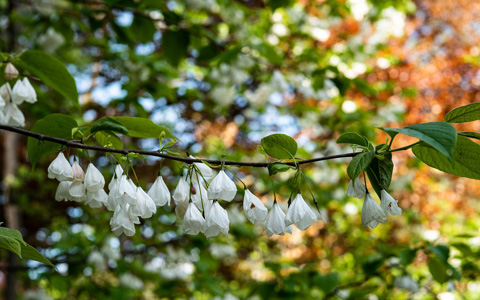
This species reaches a mature height of 30 to 40 feet with its crown reaching up to 35 feet in diameter, and has a rounded or vase-shape.
• Flowering period is April through May with flowers best observed from below as they hang from pendulous stalks in clusters of 2 to 5.
• Colors include white and sometimes rose flowers in spring, green fruit in late summer turning light-brown in fall, and dark green foliage that turns yellow before falling in autumn.
• Soil should be acidic and well-drained with considerable amounts of organic material.
• This species flourishes when grown in light shade and a protected environment.
• Pruning activities should occur either in early or late winter while the tree is in a state of dormancy.
• Susceptible to tree scale when stressed. Healthy Carolina silverbells are otherwise pest-resistant.
Your Carolina silverbell should flourish with minimal seasonal maintenance. However, in the event of drought or changes in the soil pH, the tree may become stressed and appear to droop or wilt. In these cases, call a certified arborist to evaluate the tree, environment, and soil to suggest the best course of action.
After you select some flowering trees for your yard, visit 72tree.com/3-evergreen-species-alpharetta-roswell-yard/ for some perfect evergreens species, 72tree.com/5-popular-alpharetta-ga-shade-trees/ if you need to add some shade to your yard, or 72tree.com/4-shrub-species-alpharetta-georgia-yard/ for the perfect shrubs that can balance your landscape out.
Southern Blooming Trees
As you drive through the streets this spring, you can marvel at some of the most beautiful flowering trees in the South!
In this article, you discovered important information about the beautiful flowering dogwood, eastern redbud, and Carolina silverbell tree species.
Without one of these flowering trees in your yard, you are passing up the opportunity to provide curb appeal and make your yard captivating.
Sources:
https://plants.usda.gov
https://www.wildflower.org/plants/result.php?id_plant=ceca4
http://www.uky.edu/hort/Flowering-Dogwood
http://www.uky.edu/hort/Carolina-Silverbell
Notice: Undefined variable: page in /home/vrxdg1855sn3/public_html/wp-content/themes/72tree/content.php on line 15
Notice: Trying to get property 'ID' of non-object in /home/vrxdg1855sn3/public_html/wp-content/themes/72tree/content.php on line 15
Crape Myrtle – A Southern Tree for Your Alpharetta and Roswell Yard
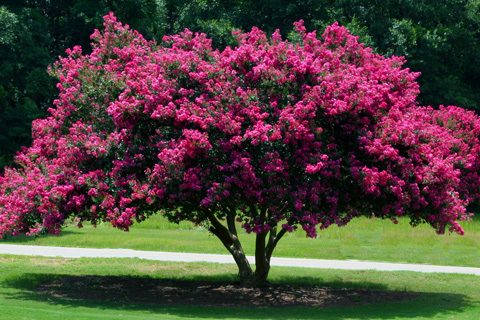
Lagerstroemia, known as crepe myrtle or crape myrtle is a tree that thrives in US Hardiness zones 7 through 10, making it a perfect choice for your Alpharetta or Roswell yard. The genus came to the US over 200 years ago and got its name from the Swedish merchant Magnus von Lagerstrom.
The most popular species is L. indica. It is a native of southern China and Thailand. For centuries, crepe myrtles have been grown in Asia as ornamentals.
Of all the southern trees and plants, crepe myrtles are among the most desired for their outstanding summer display of blooms and their brilliant fall colors. 72 Tree, Seed & Land Co. prepared an extensive article covering the characteristics, environment, and care these trees need to flourish and light up your landscape.
Are Crepe Myrtles Trees or Bushes
The Lagerstroemia genus contains approximately 50 species of trees and shrubs both deciduous and evergreen. So, this species can indeed grow as a tree or shrub, making it ideal for hedges, container planting, or even in groupings along your landscape.
Height – The L. indica species possesses cultivars and hybrids that remain under 5ft in height, some that reach 11 to 15ft in height, and those that tower over the others, reaching heights of 20 to 30ft.
Canopy – At maturity, the canopy can reach from 6ft to well beyond 15ft depending on the species.
Trunk – Crape Myrtles are known to have multiple trunks with beautiful bark which exfoliates in the winter months. Be cautious when pruning or working around these trees, their wood is somewhat brittle, and the trunks may easily crack when put under pressure.
Lifespan – When planted in full sun and fertile soil, Crepe Myrtles can live well beyond 50 years. In fact, dotted along the southeastern landscape, it is common to come across specimens over 100 years old.
Uses – Depending on the species, these trees work as shrubs, hedges, container plants, landscape groupings, and in some cities as street trees.
If you decided you prefer to plant an evergreen instead, visit 72tree.com/3-evergreen-species-alpharetta-roswell-yard/ for some great candidates.
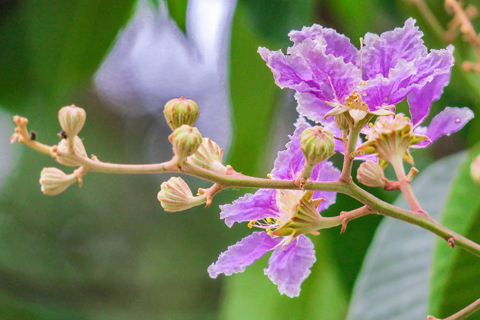
Crepe Myrtle Tree Care
About two years after planting, these species become very tolerant to drought, heat, humidity, and will do well in nearly any well-drained soil. They become robust enough to resprout even after being completely frozen.
Crepe myrtles are low maintenance. However, you still need to do some planning before planting and a bit of upkeep as they grow.
Planting – Location is critical when planting crepe myrtles. Select a spot that has well-drained soil and gets full sun. Planting in partial or full shade will significantly reduce its ability to flower and may reduce its lifespan as well.
Crepe myrtles have a shallow and very fibrous root system which can extend 3 to 4 times the diameter of the canopy. As with all trees, the planting location should be at least 5 to 10 feet away from cement pathways, foundations, and sidewalks.
Pruning – Very little pruning is required. Improper pruning disrupts the development of a robust branching system and will leave your specimen deformed and vulnerable to weather, pests, and fungi.
If there is a need to prune, it should occur in late winter or early spring to correct the following:
• Removing crossed or rubbing branches.
• Removing suckers from the base.
• Branches growing inward (toward the center).
• Canopy thinning for better air circulation.
• Gradually remove side branches up to 4 or 5 feet as the tree grows.
• Reducing multi-trunk trees to a single trunk (not recommended).
Summer pruning can include:
• Removing old seed pods and spent flowers (removing them after the first bloom encourages further blooming).
• Removing small twig-like growth.
All crepe myrtle species bloom on new wood. The proper and minimal pruning of your tree will encourage this growth and promote a beautiful summer blooming season.
If you are pruning your tree because it has gotten too large for its location, you’ve planted the wrong species.
Watering – Provide newly planted crepe myrtles with a deep and thorough watering. Then, water your tree up to 4 or 5 times per week during hot weather or when planted in sandy soil. When the tree is dormant or during cold weather, your tree will need watering once per week.
Blooms – As previously mentioned, all crepe myrtles bloom on new wood. After the first bloom, removing the spent flowers will encourage further blooming in the season.
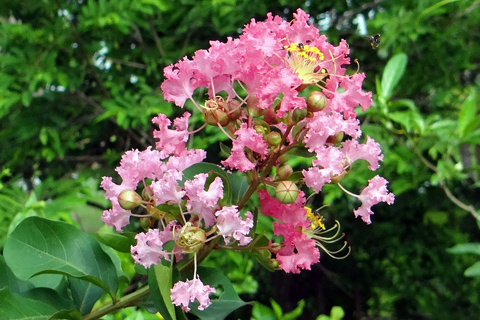
Tree Pests and Disease That Attack Crepe Myrtles
These trees like all others on your landscape are susceptible to infestations, disease, and animal damage. The best defense against these threats is to keep your tree(s) healthy, plant, prune, and water them properly and they will be less likely to suffer damage from the following:
Pests that infest crepe myrtles:
Japanese Beetle – This insect is approximately 1/2 inch in length, its body is oval and metallic green, and its wings are copper in color.
Larvae remain underground where they consume grass and young tree roots. Adult beetles feed on the tissues of the leaves and are most active on trees in full sun during the warmest part of the day.
A Japanese beetle infestation can cause severe damage to all of the trees on your landscape. Traps, pyrethrins, and neem oil can help curtail a beetle outbreak. However, this is an urgent situation which needs to be evaluated by a certified arborist.
Crape Myrtle Aphid – These insects are yellowish-green and have black spots on their abdomen. They measure from a sixteenth to an eighth of an inch in length.
Both nymphs and adults feed on the underside of the foliage causing it to droop and yellow leaf spots to appear. Buds, flowers, and branch tips can all be damaged as well from their feeding.
Sooty mold will appear on the leaves when there is an aphid infestation. This mold is a byproduct of the aphid’s excrement and will disappear once the outbreak ends.
Watch this video to learn how to eliminate aphids and “black” sooty mold on your crape myrtle.
When a crape myrtle aphid infestation occurs, apply a 2oz. to 1 gallon solution of molasses and water to the affected areas and release ladybugs around the tree. Neem oil is also very useful in controlling aphids.
Fungi that attack crepe myrtles:
Powdery Mildew – This fungus appears as a white powdery substance and can spread very quickly if not handled properly.
It is worth noting that trees planted in full sun are not typically bothered by this fungus.
To control powdery mildew, spray a fungicide on the affected area and its surroundings.
Sooty Mold – This mold has a tar-like appearance and is a result an aphid infestation (see above).
Bark Shedding – Don’t be alarmed. While it may seem that something has infected your tree, there is nothing wrong with it. Crepe myrtles, once reaching adulthood will naturally exfoliate their bark in winter months, revealing the magnificent color variations of its trunk.
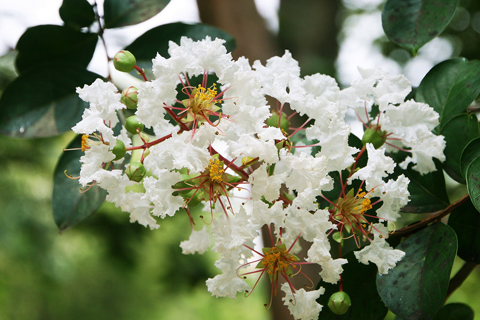
Crepe Myrtles and Summer Blooms
If you are looking for an incredible addition to your Alpharetta yard or landscape, crepe myrtles are a must have. Besides being low maintenance, they will put on a colorful show every summer.
An added plus in the summer is when the blooms attract birds seeking refuge and nesting and offer their nectar and pollen to the bees.
Sources:
https://en.wikipedia.org/wiki/Lagerstroemia
https://www.leugardens.org/wp-content/uploads/2014/07/Crepe_myrtles.pdf
https://crapemyrtletrails.org/crape-myrtle-history/
http://www.pcmg-texas.org/images/trees/crape_myrtle_pest.pdf
https://crapemyrtletrails.org/pest-control/
